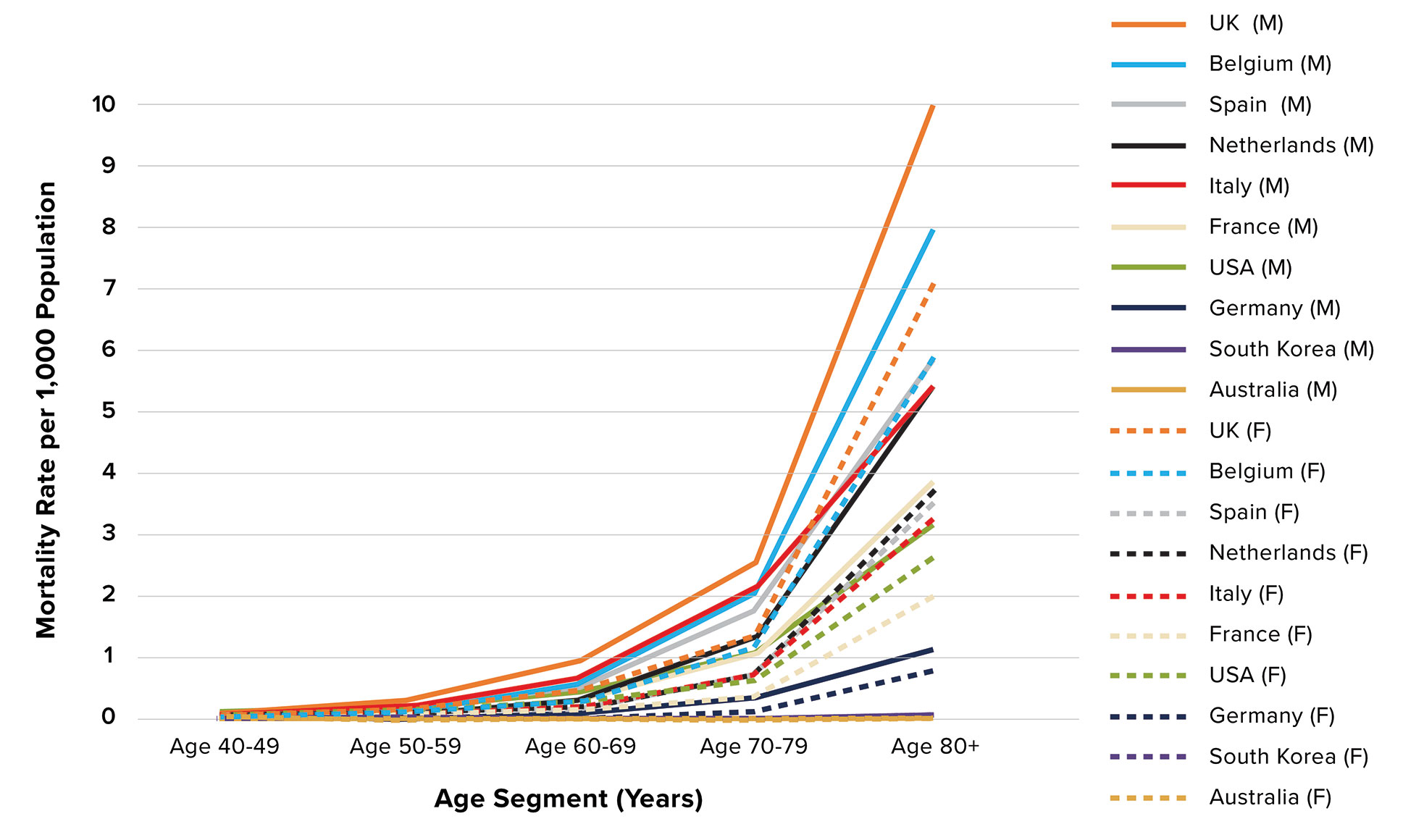It is well-known that the relationship between human all-cause mortality risk and age can be represented by the Gompertz model – one of the oldest mathematical formulations in actuarial science and human demography.
Our research shows that the risk of dying with COVID-19 can also be modelled using a Gompertz parametric description, allowing some important differences by age, gender, and country to be highlighted.
Review of Current Trends
In this research brief, we draw on publicly available data to help understand who is at greatest risk of dying with COVID-19. Figure 1 below shows COVID-19 mortality rates per 1,000 population (as of June 2, 2020) by age and gender in adults aged 40 years and above for ten countries: the UK, Belgium, Spain, the Netherlands, Italy, France, the U.S., Germany, South Korea, and Australia. Figure 2 presents the data in Figure 1 on the log10 scale.
Figure 1:
Mortality rate by age and gender

Note: Some data have been smoothed in order to show consistent age segments.
In people aged 40 years and older, Figures 1 and 2 highlight that COVID-19 mortality risk increases with age and is higher in males compared to females. Further, Figure 2 demonstrates that COVID-19 mortality rates exhibit a precise pattern of exponential increase with age.
Applying the Gompertz model
The exponential pattern observed with respect to COVID-19’s mortality rate with age suggests it can be modelled using the Gompertz function, with formula:
m(t) = Aeαt
where m(t) is the mortality rate for an adult with age (t), while α and A are free parameter to estimate; α is the rate of age-related increase in mortality (also known as the “senescent component”) and A represents the baseline mortality, which can be thought of as an aggregate of different environmental factors.
Estimating α enables the derivation of the mortality rate doubling time (MRDT) for COVID-19 – the age increment necessary for COVID-19’s mortality rate to double:
Estimate of COVID-19’s Mortality Rate Doubling Time | Countries |
|---|
5 years | Netherlands |
6 years | Italy, Germany, Spain, South Korea, Belgium, Australia |
7 years | France, U.K. |
8 years | USA |
In over half of the countries analyzed, COVID-19’s MRDT is estimated as 6 years. This suggests that, compared to a 20-year-old, an 80-year-old (being 60 years older) has approximately 210 times the risk of dying from COVID-19 (roughly 1000 times the risk).
Figure 3 illustrates all-cause MRDTs and COVID-19 MRDTs for the ten countries analyzed. All-cause mortality estimates of the MRDT were calculated using data from the Human Mortality Database.
Figure 3
Mortality Rate Doubling Time (MRDT)
 Population all-cause MRDTs are all in the range of 7 to 8, with the exception of the U.S. which has an MRDT of 9. These estimates are consistent with this study. COVID-19’s MRDT is shorter than the equivalent all-cause MRDT in every country, implying COVID-19’s mortality rate by age is steeper. Moreover, within a country, the MRDTs for each sex are similar, but steeper for males.
Population all-cause MRDTs are all in the range of 7 to 8, with the exception of the U.S. which has an MRDT of 9. These estimates are consistent with this study. COVID-19’s MRDT is shorter than the equivalent all-cause MRDT in every country, implying COVID-19’s mortality rate by age is steeper. Moreover, within a country, the MRDTs for each sex are similar, but steeper for males.
Summary
COVID-19 could be viewed as having an “additional mortality” impact on populations across the age segments shown here, due to its similar MRDT to population all-cause mortality. COVID-19 mortality rates reflect the average risk of dying with COVID-19 for a particular age, but an individual’s risk of dying will very much depend on his or her underlying health and other risk factors. Nonetheless, MRDTs are shorter for COVID-19 (i.e., the risk with age is steeper) compared with all-cause in all countries as well as for males compared with females. The shorter MRDT associated with COVID-19 may, in part, be driven by an ‘intensification’ or an ‘acceleration’ to the risk of dying in some people with underlying health conditions or other risk factors.
Finally, the limitations of these data are important to consider and differ by country, which we discussed in this article. Most notably, different countries have adopted different definitions with respect to reporting COVID-19 deaths.





 Population all-cause MRDTs are all in the range of 7 to 8, with the exception of the U.S. which has an MRDT of 9. These estimates are consistent with
Population all-cause MRDTs are all in the range of 7 to 8, with the exception of the U.S. which has an MRDT of 9. These estimates are consistent with 


